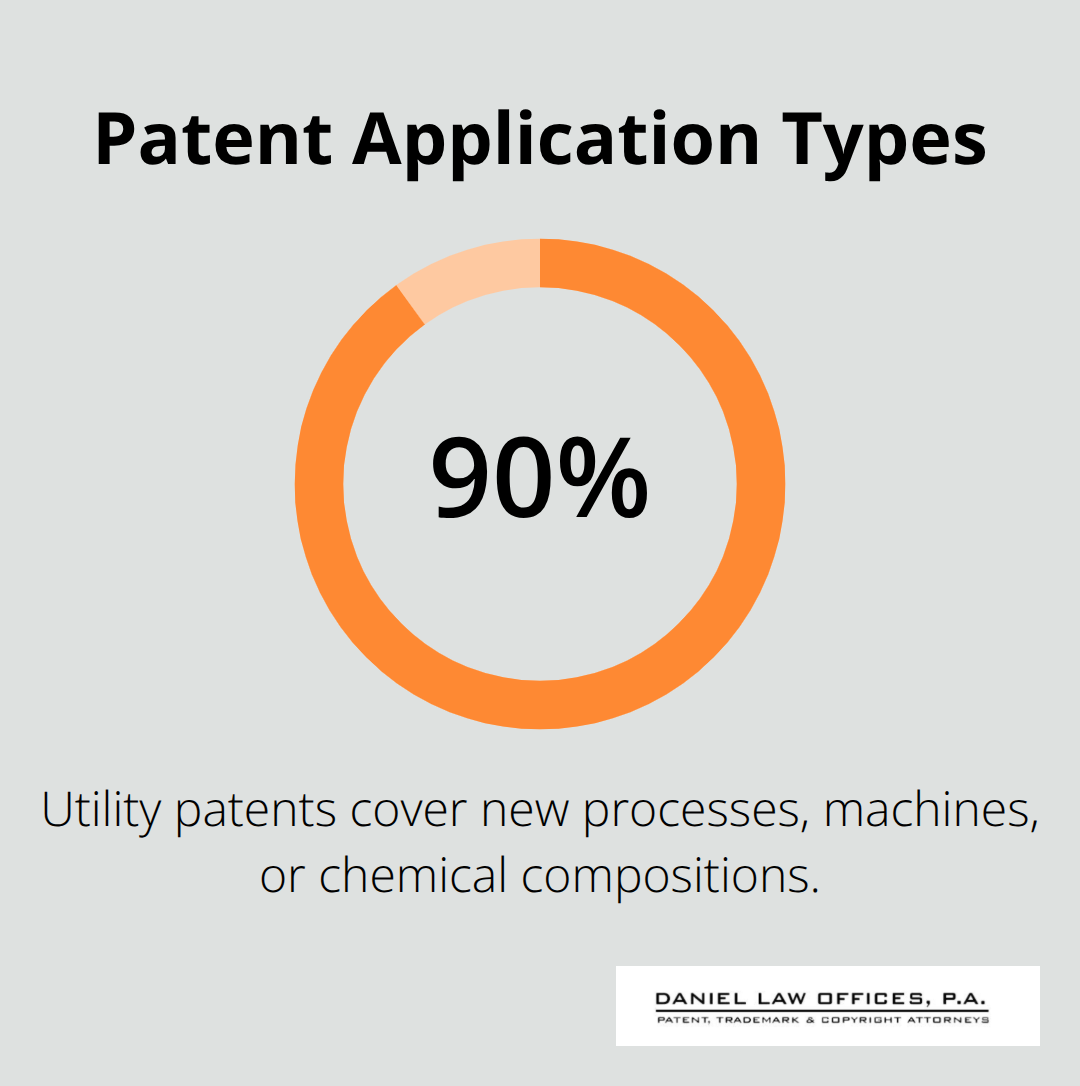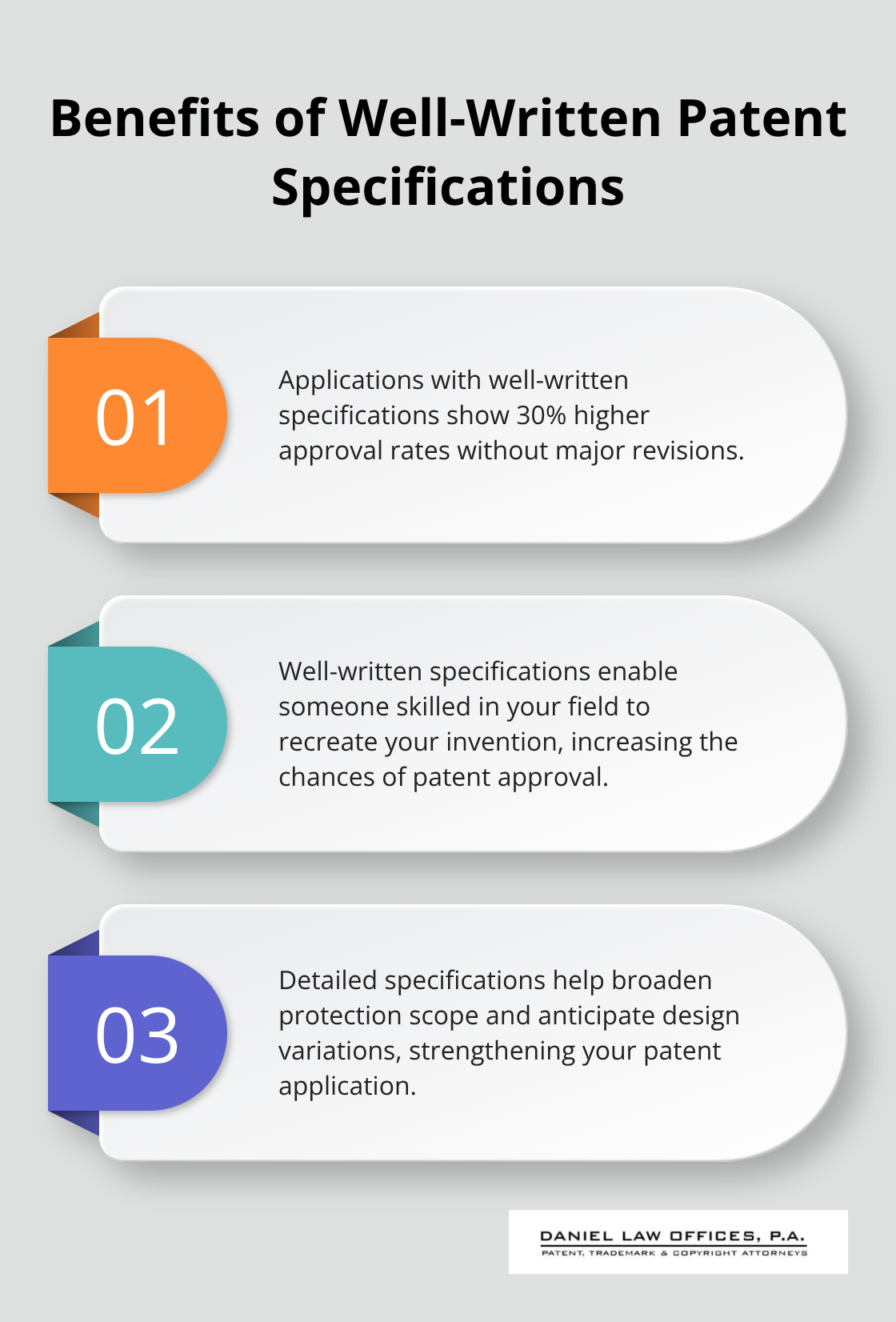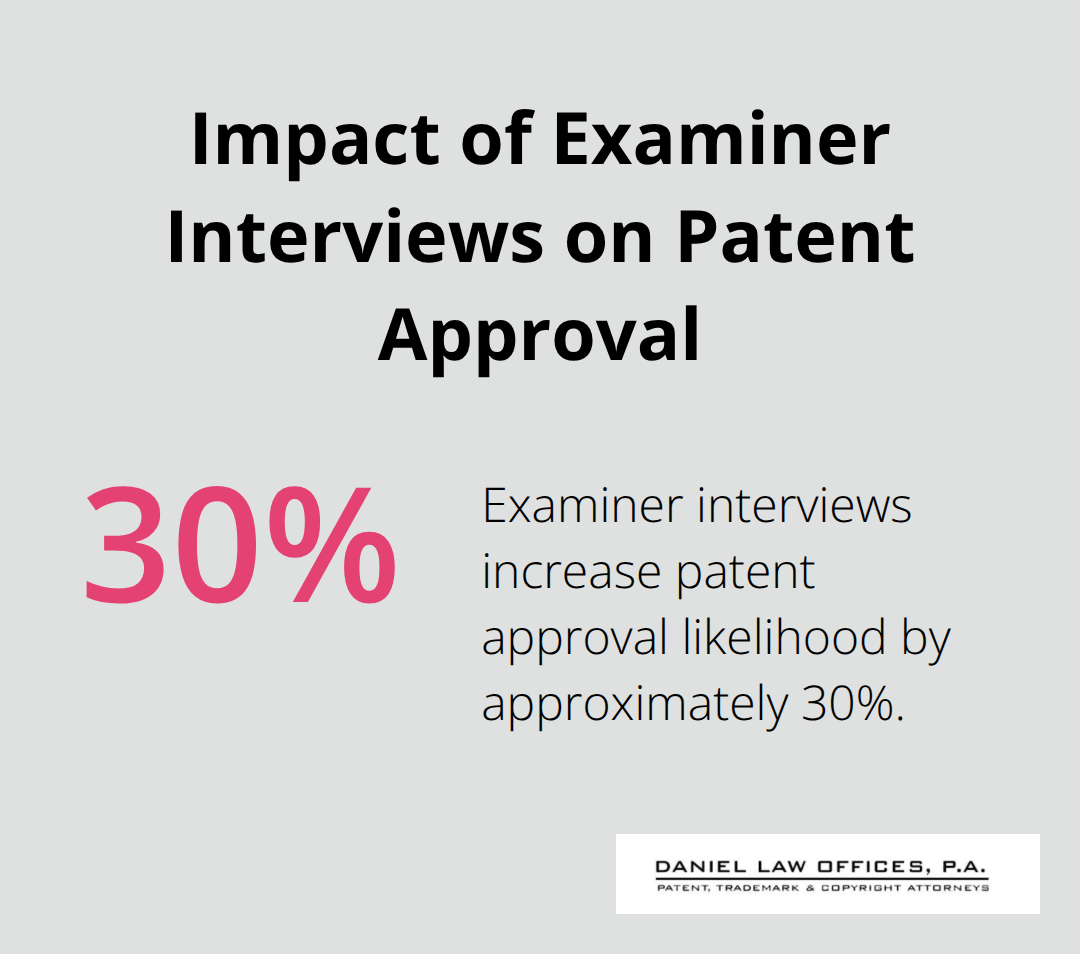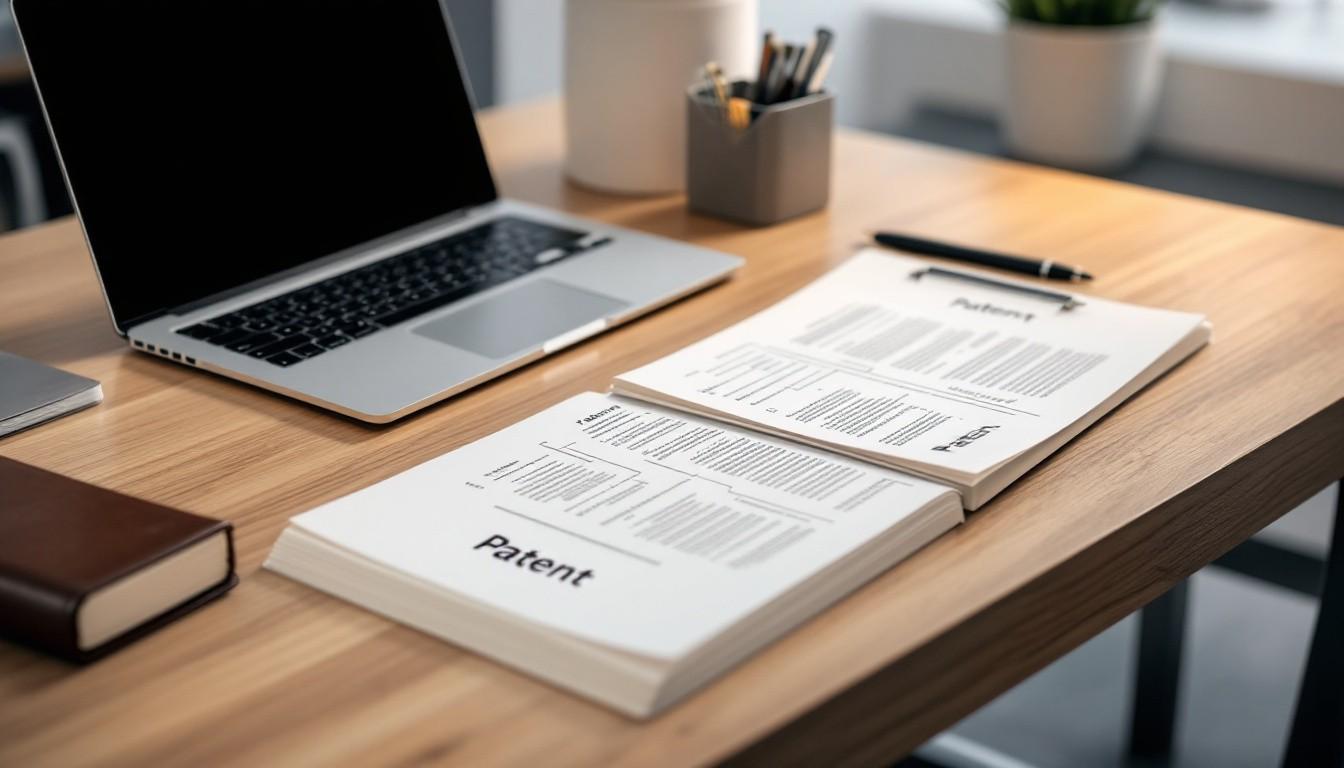How to Navigate the Patent Application Process in Orlando, Florida
The patent application process can feel overwhelming for inventors in Orlando. With over 650,000 patent applications filed annually with the USPTO, understanding each step becomes vital for success.
We at Daniel Law Offices, P.A. guide local inventors through this complex journey. From initial searches to final approval, proper legal support makes the difference between approval and rejection.
Understanding the Patent Application Process
The USPTO grants three distinct patent types, each protecting different innovations. Utility patents cover new processes, machines, or chemical compositions and represent 90% of all applications filed. Design patents protect ornamental appearances of manufactured items for 15 years. Plant patents safeguard new plant varieties developed through asexual reproduction methods.

USPTO Standards You Must Meet
Patent applications face strict requirements that cause 60% to receive initial rejections. Your invention must demonstrate novelty, non-obviousness, and utility to pass examination. The USPTO requires complete specifications that average 10,000 words, precise technical drawings that follow specific format rules, and claims that clearly define your invention’s scope.
Applications that receive professional preparation show 10% higher approval rates without major revisions (according to USPTO statistics). Electronic submission through Patent Center reduces processing time by 15% compared to paper submissions, which carry an additional $400 fee penalty.
Timeline Reality Check
Patent prosecution typically spans 18 to 24 months from submission to final decision. Initial examination begins 12 to 18 months after you file, with 86% of applications receiving at least one Office Action that requires response within six months. Provisional applications provide temporary protection for 12 months but require conversion to non-provisional status to maintain your original date.
Fee Structure Breakdown
The USPTO charges different rates based on entity size. Large entities pay $320 for basic filing fees, while small entities pay $160 and micro entities pay just $80. Maintenance fees become due at 3.5, 7.5, and 11.5 years after grant to prevent patent expiration.
Success in patent prosecution depends heavily on thorough preparation before you submit your application.
How Do You Build a Strong Patent Application?
Successful patent applications start with comprehensive prior art searches that reveal what already exists in your field. The USPTO Patent Public Search database contains over 11 million granted patents and published applications, but you must use strategic keyword combinations and classification searches to navigate this system effectively. About 8% of applications face rejection for lack of novelty, which makes thorough searches non-negotiable. The Orange County Library System Patent and Trademark Resource Center helped over 500 local inventors with patent inquiries in 2022 (demonstrating the value of these free resources). Professional search services cost between $1,000 to $3,000 but identify prior art that amateur searches often miss.
Documentation Standards That Pass USPTO Review
Your patent application must include detailed descriptions of functionality, methods of manufacture, and technical specifications that enable someone skilled in your field to recreate your invention. Applications with well-written specifications show 30% higher approval rates without major revisions according to USPTO data. Document every component, material choice, and operational step with precision measurements and tolerances. Include multiple embodiments of your invention to broaden protection scope and anticipate design variations. Well-drafted claims lead to 25% fewer initial rejections, which makes clarity and precision vital throughout your documentation.

Technical Drawing Requirements
Patent drawings must follow strict USPTO format rules that include specific line weights, margins, and label conventions. Over 90% of utility patent applications include technical illustrations, and high-quality drawings increase approval rates by 20% according to USPTO statistics. Each drawing element requires numbered callouts that correspond to detailed descriptions in your specification. Computer-aided design software produces cleaner illustrations than hand drawings, but both must show your invention from multiple angles and cross-sectional views when internal components matter. Missing or inadequate drawings cause immediate application rejections that delay prosecution by months.
Common Application Mistakes to Avoid
Inadequate enablement or best mode disclosure causes 15% of patent invalidations in litigation (emphasizing the need for thoroughness in applications). Many inventors fail to include proper drawings as required by the Manual of Patent Examination Procedure, which leads to automatic rejections. Public disclosure of your invention starts a one-year countdown to file your patent application, after which your invention becomes public domain. Types of public disclosures that trigger this deadline include public demonstrations, sales, and published descriptions of your invention.
With your application properly prepared, the next step involves selecting the right legal representation to guide you through USPTO prosecution.
Why Choose Orlando Patent Attorneys
Local patent attorneys in Orlando understand Florida’s innovation landscape and maintain direct relationships with USPTO examiners that can accelerate your application timeline. Orlando-based practitioners handle patent prosecution more efficiently because they operate in the same time zone as the USPTO (which enables real-time communication during critical examination phases). Applications prepared with professional help show 10% higher approval rates without major revisions according to USPTO statistics, and local attorneys provide face-to-face consultations that remote firms cannot match.
What Makes a Strong Patent Attorney
Your patent attorney must hold active USPTO registration and demonstrate extensive prosecution experience in your technology field. Attorneys with 5+ years of USPTO practice show significantly higher success rates than recent practitioners, particularly when they handle complex Office Actions that affect 86% of applications. Look for attorneys who provide detailed fee estimates upfront, offer regular status updates throughout prosecution, and maintain transparent communication about potential challenges.
Experience in Your Technology Area
Patent attorneys who focus on your specific technology sector understand the technical nuances that generic practitioners often miss. They know which prior art references examiners typically cite in your field and can anticipate potential rejections before they occur. This technical knowledge becomes particularly valuable when you need to draft claims that distinguish your invention from existing patents in crowded technology spaces.
Communication and Transparency Standards
Top patent attorneys respond to client inquiries within 24 hours and provide detailed explanations of USPTO communications in plain language. They schedule regular check-ins throughout the prosecution process and explain each Office Action in terms that inventors can understand. Attorneys who maintain transparent billing practices itemize their time and provide monthly statements that track prosecution costs against initial estimates.
Strategic Prosecution Approach
Effective patent attorneys begin each case with comprehensive prior art analysis that goes beyond basic USPTO searches (identifying potential claim scope limitations before drafting begins). They schedule examiner interviews for complex cases because these conversations increase approval likelihood by approximately 30% according to USPTO data. Strong practitioners respond to Office Actions within 30 days rather than wait until the six-month deadline, which demonstrates diligence to examiners and expedites final decisions.

Final Thoughts
The patent application process in Orlando demands careful preparation, complete documentation, and strategic legal support to achieve success. With 60% of applications receiving initial rejections and only 10% higher approval rates for professionally prepared submissions, inventors face significant challenges when they attempt to navigate USPTO requirements alone. Professional legal support transforms complex regulations into manageable steps that protect intellectual property effectively.
Attorneys who understand Florida’s innovation landscape provide the technical knowledge and prosecution experience that generic practitioners cannot match. They handle Office Actions that affect 86% of applications and conduct examiner interviews that increase approval likelihood by 30%. Orlando inventors benefit from local representation that operates in the same time zone as the USPTO and maintains direct relationships with patent examiners.
Orlando inventors ready to protect their innovations should begin with comprehensive prior art searches and detailed invention documentation. The next step involves selection of qualified legal representation that offers transparent communication and proven USPTO success rates. We at Daniel Law Offices, P.A. guide individual inventors and businesses through comprehensive patent searches, application preparation, and the entire patent prosecution process (our registered patent attorney helps clients navigate intellectual property law complexities while protecting valuable innovations and brand identities through patents and trademarks).

